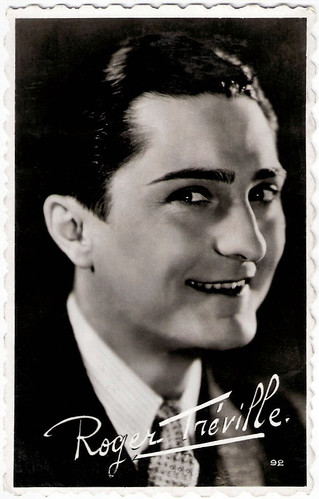
French postcard by Editions and Publications Cinématographiques, no. 92.
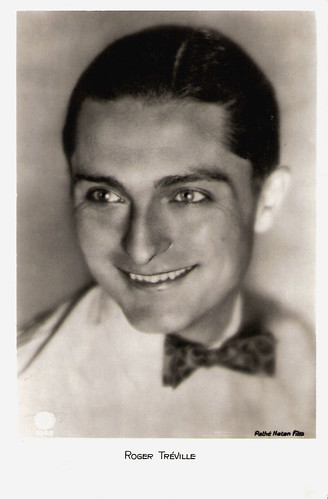
French postcard, no. 1048. Photo: Pathé Natan Film.
Chéri
Roger Tréville was born as Roger Troly in Joigny, France, in 1902. His parents were actress Fanny Delisle, and actor-author-director Georges Tréville, who directed seven films between 1912 and 1930. Roger made his film debut in 1908 at the side of his mother. His father directed him in the silent British production Married Life (1921, Georges Tréville). Roger followed this appearance with more roles in British films like the comedy The Rotters (1921, A.V. Bramble) and the drama Sinister Street (1922, George Beranger). In 1922, he returned to France and because of his perfect English he was engaged by Henry Bernstein for the play Les vignes du Seigneur (Our Lord's Vineyard). Next he appeared in Chéri (Darling) at the side of the author, the legendary Colette. He also appeared in such silent films as the Alphonse Daudet adaptation Jack (1925, Robert Saidreau). With his beautiful voice he was perfect for the sound film. His breakthrough was the comedy The Parisian (1930, Jean de Limur) with Adolphe Menjou and Elissa Landi. Among his films of the early 1930’s were also Son altesse l’amour/His Highness Love (1931, Robert Péguy, Erich Schmidt) with Annabella, Enlevez-moi/Abduct Me (1932, Leonce Perret) with Arletty, Minuit, place Pigalle/Midnight, Place Pigalle (1934, Roger Richebé) with Raimu, and Parlez moi d’amour/Speak To Me of Love (1935, René Guissart). In the second half of the 1930’s he mainly worked as a singer who recorded several records.

French postcard by A.N., Paris, no. 690. Photo: Pathé-Natan.
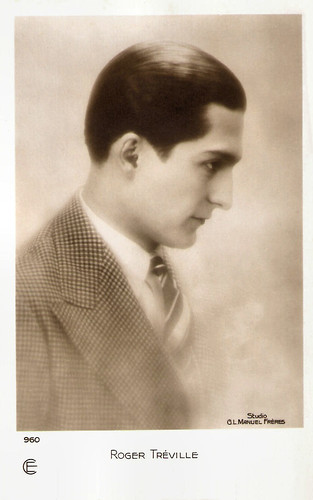
French postcard by Cinemagazine-Edition, Paris, no. 960. Photo: Studio G.L. Manuel Frères.
Beautiful Timbre
After the war Roger Tréville appeared with Marta Eggerth and Jan Kiepura in the musical Valse brillante/Brilliant Waltz (1949, Jean Boyer). His best known French films of the post-war period are the Bourvil comedy Le passe-muraille/Mr. Peek-a-Boo (1951, Jean Boyer), and La mariée était trop belle/The Bride Is Too Beautiful (1956, Pierre Gaspard-Huit) with Brigitte Bardot. He was also seen in the American productions The Green Glove (1952, Rudolph Maté) starring Glenn Ford, and The Happy Road (1957, Gene Kelly). In France, he became best known as the French dubbing voice of Robert Mitchum, James Stewart, and Vittorio de Sica. With his beautiful timbre he also dubbed Cary Grant in Monkey Business (1952, Howard Hawks), Tom Ewell in The seven year Itch (1955, Billy Wilder), and Trevor Howard in Twinky (1970, Richard Donner). He was seen in a supporting role in the Hollywood comedy How to Steal a Million (1966, William Wyler) starring Audrey Hepburn. From then on he focussed on his hobby painting and appeared only incidentally in films and on TV. At the age of 101 he founded Fonds Roger Tréville for the films and archives of Georges and Roger Tréville. A year later, in 2005, Roger Treville died in Beaumont, France, of natural causes. He was married twice; the second time with singer Rose Lorraine.
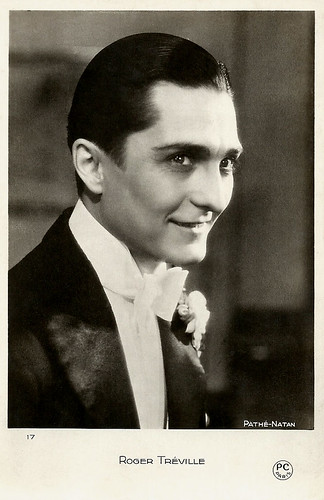
French postcard by P.C., Paris, no. 17. Photo: Pathé-Natan.
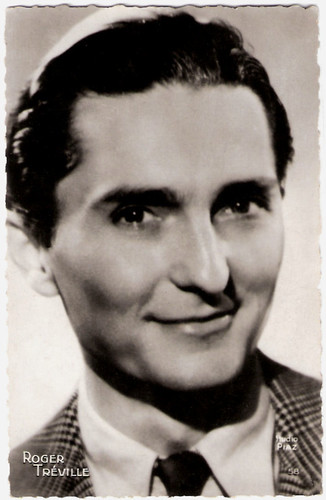
French postcard by Editions P.I., Paris, no. 58. Photo: Studio Piaz.
Sources: Fonds Roger Treville, Wikipedia (French) and IMDb.
He reminds me of Bela Lugosi. He would have been good in 1930s vampire movies.
ReplyDeleteHa ha, great idea.
ReplyDelete